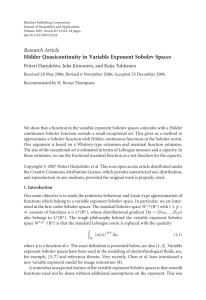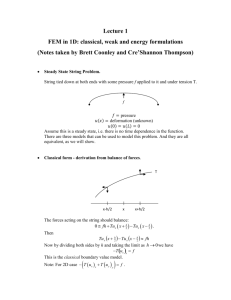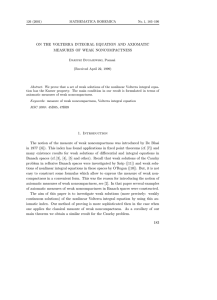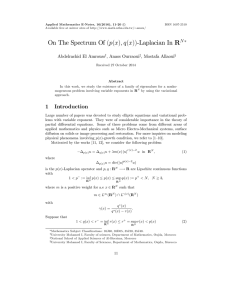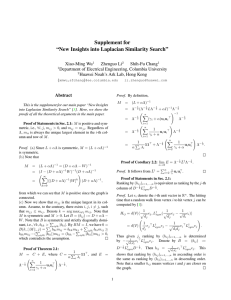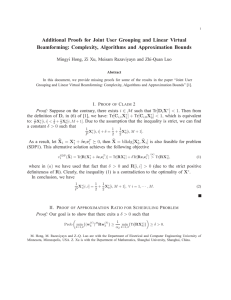Electronic Journal of Differential Equations, Vol. 2009(2009), No. 144, pp.... ISSN: 1072-6691. URL: or
advertisement
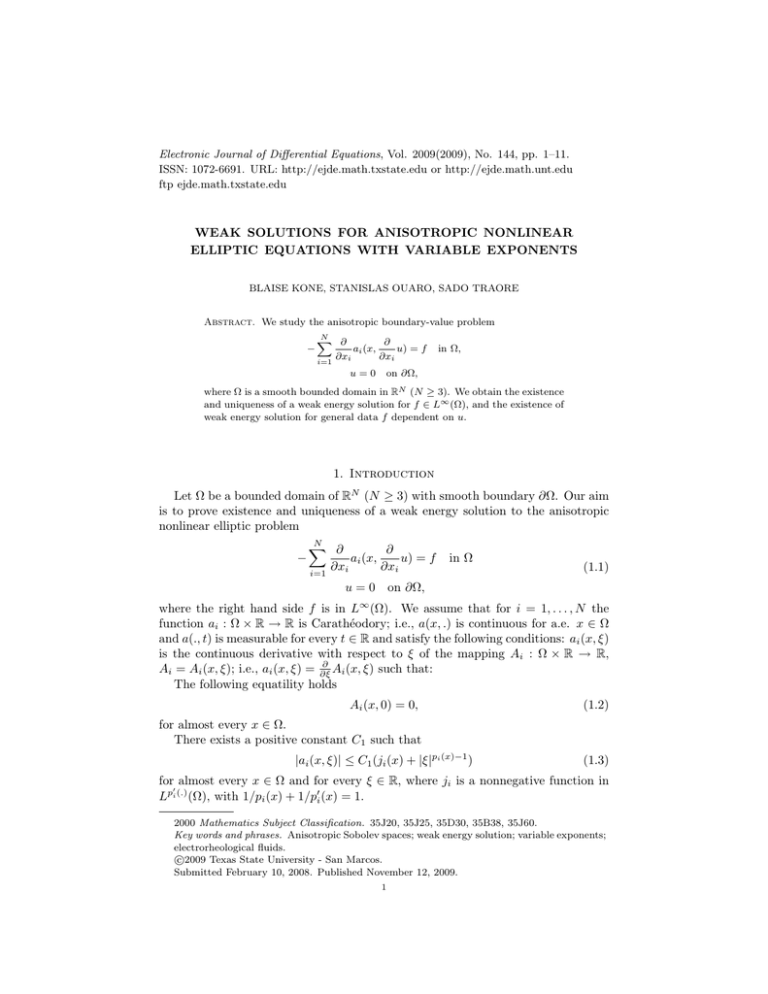
Electronic Journal of Differential Equations, Vol. 2009(2009), No. 144, pp. 1–11.
ISSN: 1072-6691. URL: http://ejde.math.txstate.edu or http://ejde.math.unt.edu
ftp ejde.math.txstate.edu
WEAK SOLUTIONS FOR ANISOTROPIC NONLINEAR
ELLIPTIC EQUATIONS WITH VARIABLE EXPONENTS
BLAISE KONE, STANISLAS OUARO, SADO TRAORE
Abstract. We study the anisotropic boundary-value problem
−
N
X
∂
∂
ai (x,
u) = f
∂x
∂x
i
i
i=1
u=0
in Ω,
on ∂Ω,
where Ω is a smooth bounded domain in RN (N ≥ 3). We obtain the existence
and uniqueness of a weak energy solution for f ∈ L∞ (Ω), and the existence of
weak energy solution for general data f dependent on u.
1. Introduction
Let Ω be a bounded domain of RN (N ≥ 3) with smooth boundary ∂Ω. Our aim
is to prove existence and uniqueness of a weak energy solution to the anisotropic
nonlinear elliptic problem
−
N
X
∂
∂
ai (x,
u) = f
∂x
∂x
i
i
i=1
in Ω
(1.1)
u = 0 on ∂Ω,
where the right hand side f is in L∞ (Ω). We assume that for i = 1, . . . , N the
function ai : Ω × R → R is Carathéodory; i.e., a(x, .) is continuous for a.e. x ∈ Ω
and a(., t) is measurable for every t ∈ R and satisfy the following conditions: ai (x, ξ)
is the continuous derivative with respect to ξ of the mapping Ai : Ω × R → R,
∂
Ai = Ai (x, ξ); i.e., ai (x, ξ) = ∂ξ
Ai (x, ξ) such that:
The following equatility holds
Ai (x, 0) = 0,
(1.2)
for almost every x ∈ Ω.
There exists a positive constant C1 such that
|ai (x, ξ)| ≤ C1 (ji (x) + |ξ|pi (x)−1 )
(1.3)
for almost every x ∈ Ω and for every ξ ∈ R, where ji is a nonnegative function in
0
Lpi (.) (Ω), with 1/pi (x) + 1/p0i (x) = 1.
2000 Mathematics Subject Classification. 35J20, 35J25, 35D30, 35B38, 35J60.
Key words and phrases. Anisotropic Sobolev spaces; weak energy solution; variable exponents;
electrorheological fluids.
c
2009
Texas State University - San Marcos.
Submitted February 10, 2008. Published November 12, 2009.
1
2
B. KONE, S. OUARO, S. TRAORE
EJDE-2009/144
The following inequality holds
ai (x, ξ) − ai (x, η) . ξ − η > 0
(1.4)
for almost every x ∈ Ω and for every ξ, η ∈ R, with ξ 6= η.
The following inequalities hold
|ξ|pi (x) ≤ ai (x, ξ).ξ ≤ pi (x)Ai (x, ξ)
(1.5)
for almost every x ∈ Ω and for every ξ ∈ R.
For the exponent p1 (.), . . . , pN (.), we assume that pi (.) : Ω → R are continuous
functions such that:
N
X
1
2 ≤ pi (x) < N,
> 1,
(1.6)
p−
i=1 i
where
+
p−
i := ess inf pi (x), pi := ess sup pi (x).
x∈Ω
x∈Ω
A prototype example that is covered by our assumptions is the following anisotropic
(p1 (.), . . . , pN (.))-harmonic problem: Set
Ai (x, ξ) = 1/pi (x) |ξ|pi (x) , ai (x, ξ) = |ξ|pi (x)−2 ξ
where pi (x) ≥ 2. Then we obtain the problem:
−
N
X
∂ ∂ pi (x)−2 ∂ |
u|
u =f
∂xi ∂xi
∂xi
i=1
which, in the particular case when pi = p for any i ∈ {1, . . . , N } is the p(.)-Laplace
equation.
The study of nonlinear elliptic equations involving the p-Laplace operator is
based on the theory of standard Sobolev spaces W m,p (Ω) in order to find weak
solutions. For the nonhomogeneous p(.)-Laplace operators, the natural setting for
this approach is the use of the variable exponent Lebesgue and Sobolev spaces
Lp(.) (Ω) and W m,p(.) (Ω). The spaces Lp(.) (Ω) and W m,p(.) (Ω) were thoroughly
studied by Musielak [18], Edmunds et al [7, 8, 9], Kovacik and Rakosnik [13],
Diening [5, 6] and the references therein.
Variable Sobolev spaces have been used in the last decades to model various
phenomena. Chen, Levine and Rao [4] proposed a framework for image restoration
based on a variable exponent Laplacian. An other application which uses nonhomogeneous Laplace operators is related to the modelling of electrorheological fluids.
The first major discovery in electrorheological fluids is due to Willis Winslow in
1949. These fluids have the interesting property that their viscosity depends on the
electric field in the fluid. They can raise the viscosity by as much as five orders of
magnitude. This phenomenon is known as the Winslow effect. For some technical
applications, consult Pfeiffer et al [19]. Electrorheological fluids have been used in
robotics and space technology. The experimental research has been done mainly in
the USA, for instance in NASA Laboratories. For more information on properties,
modelling and the application of variable exponent spaces to these fluids, we refer
to Diening [5], Rajagopal and Ruzicka [20], and Ruzicka [21].
In this paper, the operator involved in (1.1) is more general than the p(.)-Laplace
operator. Thus, the variable exponent Sobolev space W 1,p(.) (Ω) is not adequate
to study nonlinear problems of this type. This lead us to seek weak solutions
for problems (1.1) in a more general variable exponent Sobolev space which was
EJDE-2009/144
WEAK SOLUTIONS FOR ANISOTROPIC EQUATIONS
3
introduced for the first time by Mihaı̈lescu et al [16]. Note that, Antontsev and
Shmarev [2] studied the following problem which is quite close to (1.1):
X
−
Di (ai (x, u))|Di u|pi (x)−2 Di u + c(x, u)|u|σ(x)−2 u = F (x) in Ω
(1.7)
i
u = 0 on ∂Ω,
in a bounded domain Ω ∈ RN , and elliptic systems of the same structure,
X
−
Dj (aij (x, ∇u)) = f i (x, u) in Ω, i = 1, . . . , n.
(1.8)
j
u=0
on ∂Ω.
In [2], the authors proved among others result, existence of (bounded) weak solutions and establish sufficient conditions of uniqueness of a weak solution, where the
variational set considered is
V(Ω) = {u ∈ Lσ(x) (Ω) ∩ W01,1 (Ω), Di (u) ∈ Lpi (x) (Ω), i = 1, . . . , n}
Pn
equipped with the norm kukV = kukσ(.) + i=1 kDi ukpi (.) .
The remaining part of this paper is organized as follows: Section 2 is devoted
to mathematical preliminaries including, among other things, a brief discussion of
variable exponent Lebesgue, Sobolev and anisotropic Sobolev variables exponent
spaces. The main existence and uniqueness result is stated and proved in section
3. Finally, in section 4, we discuss some extensions.
2. Preliminaries
In this section, we define the Lebesgue and Sobolev spaces with variable exponent
and give some of their properties. Roughly speaking, anistropic Lebesgue and
Sobolev spaces are functional spaces of Lebesgue’s and Sobolev’s type in which
different space directions have different roles.
Given a measurable function p(.) : Ω → [1, ∞). We define the Lebesgue space
with variable exponent Lp(.) (Ω) as the set of all measurable function u : Ω → R for
which the convex modular
Z
ρp(.) (u) :=
|u|p(x) dx
Ω
is finite. If the exponent is bounded; i.e., if p+ < ∞, then the expression
|u|p(.) := inf{λ > 0 : ρp(.) (u/λ) ≤ 1}
defines a norm in Lp(.) (Ω), called the Luxembourg norm. The space (Lp(.) (Ω), |.|p(.) )
is a separable Banach space. Moreover, if p− > 1, then Lp(.) (Ω) is uniformly convex,
0
1
+ p0 1(x) = 1.
hence reflexive, and its dual space is isomorphic to Lp (.) (Ω), where p(x)
Finally, we have the Hölder type inequality:
Z
1
1 uv dx ≤
+ 0 |u|p(.) |v|p0 (.) ,
(2.1)
p−
p−
Ω
0
for all u ∈ Lp(.) (Ω) and v ∈ Lp (.) (Ω). Now, let
W 1,p(.) (Ω) := {u ∈ Lp(.) (Ω) : |∇u| ∈ Lp(.) (Ω)},
which is a Banach space equipped with the norm
kuk1,p(.) := |u|p(.) + |∇u|p(.) .
4
B. KONE, S. OUARO, S. TRAORE
EJDE-2009/144
An important role in manipulating the generalized Lebesgue-Sobolev spaces is
played by the modular ρp(.) of the space Lp(.) (Ω). We have the following result
(cf. [11]).
Lemma 2.1. If un , u ∈ Lp(.) (Ω) and p+ < +∞ then the following relations hold
p
p
+
−
;
≤ ρp(.) (u) ≤ |u|p(.)
|u|p(.) > 1 ⇒ |u|p(.)
p−
p+
|u|p(.) < 1 ⇒ |u|p(.) ≤ ρp(.) (u) ≤ |u|p(.) ;
|un − u|p(.) → 0 ⇒ ρp(.) (un − u) → 0;
|u|Lp(.) (Ω) < 1 (respectively = 1; > 1) ⇔ ρp(.) (u) < 1 (respectively = 1; > 1);
|un |Lp(.) (Ω) → 0 (respectively → +∞) ⇔ ρp(.) (un ) → 0 (respectively →
+∞);
(vi) ρp(.) u/|u|Lp(.) (Ω) = 1.
(i)
(ii)
(iii)
(iv)
(v)
1,p(.)
Next, we define W0
kuk1,p(.) . Set
(Ω) as the closure of C0∞ (Ω) in W 1,p(.) (Ω) under the norm
C+ (Ω) = {p ∈ C(Ω) : min p(x) > 1}.
x∈Ω
Furthermore, if p ∈ C+ (Ω) is logarithmic Hölder continuous, then C0∞ (Ω) is dense
1,p(.)
1,p(.)
1,p(.)
in W0
(Ω), that is H0
(Ω) = W0
(Ω) (cf. [12]). Since Ω is an open bounded
set and p ∈ C+ (Ω) is logarithmic Hölder, the p(.)-Poincaré inequality
|u|p ≤ C|∇u|p(.)
1,p(.)
holds for all u ∈ W0
and so
(Ω), where C depends on p, |Ω|, diam(Ω) and N (see [12]),
kuk := |∇u|p(.) ,
1,p(.)
is an equivalent norm in W0
(Ω). Of course also the norm
kukp(.) :=
N
X
∂ up(.)
∂x
i
i=1
1,p(.)
1,p(.)
(Ω). Hence the space W0
(Ω) is a separable and
is an equivalent norm in W0
reflexive Banach space.
Finally, let us present a natural generalization of the variable exponent Sobolev
1,p(.)
space W0
(Ω) (cf. [16]) that will enable us to study with sufficient accuracy
→
problem (1.1). First of all, we denote by −
p : Ω → RN the vectorial function
−
1,→
p (.)
→
−
p = (p1 , . . . , pN ). The anisotropic variable exponent Sobolev space W0
(Ω) is
defined as the closure of C0∞ (Ω) with respect to the norm
−
kuk→
p (.) :=
−
1,→
p (.)
The space (W0
N
X
∂ up (.) .
i
∂x
i
i=1
−
(Ω), kuk→
p (.) ) is a reflexive Banach space (cf. [16]).
EJDE-2009/144
WEAK SOLUTIONS FOR ANISOTROPIC EQUATIONS
5
Let us introduce the following notation.
→
−
→
−
+
−
P + = (p+
P − = (p−
1 , . . . , pN ),
1 , . . . , pN ),
+
P++ = max{p+
1 , . . . , pN },
−
P−+ = max{p−
1 , . . . , pN },
−
P−− = min{p−
1 , . . . , pN },
P−,∞ = max{P−+ , P−∗ },
N
.
P−∗ = PN 1
i=1 p− − 1
i
We have the following result (cf. [16]).
Theorem 2.2. Assume Ω ⊂ RN (N ≥ 3) is a bounded domain with smooth boundary. Assume relation (1.6) is fulfilled. For any q ∈ C(Ω) verifying
1 < q(x) < P−,∞
then the embedding
−
1,→
p (.)
W0
for all x ∈ Ω,
(Ω) ,→ Lq(.) (Ω)
is continuous and compact.
We remark that Assumption (1.4) and relation ai (x, ξ) = ∇ξ Ai (x, ξ) imply in
particular that for i = 1, . . . , N , Ai (x, ξ) is convex with respect to the second
variable.
3. Existence and uniqueness of weak energy solution
In this section, we study the weak energy solution of (1.1).
−
1,→
p (.)
Definition 3.1. A weak energy solution of (1.1) is a function u ∈ W0
(Ω) such
that
Z X
Z
N
−
∂
∂
1,→
p (.)
ai (x,
u).
ϕdx =
f (x)ϕdx, for all ϕ ∈ W0
(Ω).
(3.1)
∂xi
∂xi
Ω i=1
Ω
The main result of this section is the following.
Theorem 3.2. Assume (1.2)-(1.6) and f ∈ L∞ (Ω). Then there exists a unique
weak energy solution of (1.1).
Proof of Existence. Let E denote the anisotropic variable exponent Sobolev
−
1,→
p (.)
space W0
(Ω). Define the energy functional J : E → R by
Z
Z X
N
∂
u)dx −
f u dx.
J(u) =
Ai (x,
∂xi
Ω
Ω i=1
We first establish some basic properties of J.
Proposition 3.3. The functional J is well-defined on E and J ∈ C 1 (E, R) with
the derivative given by
Z X
Z
N
∂
∂
hJ 0 (u), ϕi =
ai (x,
u).
ϕdx −
f ϕdx,
∂xi
∂xi
Ω i=1
Ω
for all u, ϕ ∈ E.
6
B. KONE, S. OUARO, S. TRAORE
EJDE-2009/144
To prove the above proposition, we define for i = 1, . . . , N the functionals Λi :
E → R by
Z
∂
Λi (u) =
Ai (x,
u)dx, for all u ∈ E.
∂x
i
Ω
Lemma 3.4. For i = 1, . . . , N ,
(i) the functional Λi is well-defined on E;
(ii) the functional Λi is of class C 1 (E, R) and
Z
∂
∂
0
hΛi (u), ϕi =
ai (x,
u).
ϕdx,
∂x
∂x
i
i
Ω
for all u, ϕ ∈ E.
Proof. (i) For any x ∈ Ω and ξ ∈ R, we have
Z 1
Z 1
d
Ai (x, tξ)dt =
ai (x, tξ).ξdt.
Ai (x, ξ) =
0
0 dt
Then by (1.3),
Z
Ai (x, ξ) ≤ C1
1
(ji (x) + |ξ|pi (x)−1 tpi (x)−1 )|ξ|dt ≤ C1 ji (x)|ξ| +
0
C1
|ξ|pi (x) .
pi (x)
The above inequality and (1.6) imply
Z
Z
Z
∂ pi (x)
∂
∂
C1
|
0≤
Ai (x,
u)dx ≤ C1
ji (x)|
u|dx + −
u|
dx,
∂x
∂x
∂x
p
i
i
i
Ω
Ω
Ω
i
for all u ∈ E. Using (2.1) and Lemma 2.1, we deduce that Λi is well-defined on E,
for i = 1, . . . , N .
(ii) Existence of the Gâteaux derivative. Let u, ϕ ∈ E. Fix x ∈ Ω and 0 < |r| < 1.
Then by the mean value theorem, there exists ν ∈ [0, 1] such that
ai (x, ∂ u(x) + νr ∂ ϕ(x)) ∂ ϕ(x)
∂xi
∂xi
∂xi
∂
∂
∂
u(x) + r
ϕ(x)) − Ai (x,
u(x))/|r|
= Ai (x,
∂xi
∂xi
∂xi
h
pi (x)−1 ∂
pi (x)−1 i ∂
+ ∂
≤ C1 ji (x) + C1 2P+ +
u(x)
ϕ(x)
ϕ(x).
∂xi
∂xi
∂xi
Next, by (2.1), we have
Z
∂
∂
C1 ji (x)|
ϕ(x)|dx ≤ β|C1 ji |p0i (x) .|
ϕ|pi (x)
∂x
∂x
i
i
Ω
and
Z
∂ pi (x)−1 ∂
∂ pi (x)−1
∂
u|
|
ϕ|dx ≤ α||
u|
|p0i (x) .|
ϕ|pi (x) .
∂xi
∂xi
∂xi
Ω ∂xi
The above inequalities imply
h
pi (x)−1 ∂
pi (x)−1 i ∂
+ ∂
C1 ji (x) + 2P+ u(x)
+
ϕ(x)
ϕ(x) ∈ L1 (Ω).
∂xi
∂xi
∂xi
It follow from the Lebesgue theorem that
Z
∂
∂
0
u)
ϕdx, for i = 1, . . . , N.
hΛi (u), ϕi =
ai (x,
∂x
∂x
i
i
Ω
|
EJDE-2009/144
WEAK SOLUTIONS FOR ANISOTROPIC EQUATIONS
7
∂
Assume now un → u in E. Let us define ψi (x, u) = ai (x, ∂x
u). Using assumption
i
0
(1.3), [13, theorems 4.1 and 4.2], we deduce that ψi (x, un ) → ψi (x, u) in Lpi (x) (Ω).
By (2.1), we obtain
|hΛ0i (un ) − Λ0i (u), ϕi| ≤ C|ψi (x, un ) − ψi (x, u)|p0i (x) |
∂
ϕ|pi (x) ,
∂xi
and so
kΛ0i (un ) − Λ0i (u)k ≤ C|ψi (x, un ) − ψi (x, u)|p0i (x) → 0,
as n → ∞ for i = 1, . . . , N . The proof is complete.
By Lemma 3.4, it is clear that Proposition 3.3 holds true and then, the proof of
Proposition 3.3 is also complete.
Lemma 3.5. For i = 1, . . . , N the functional Λi is weakly lower semi-continuous.
Proof. By [3, corollary III.8], it is sufficient to show that Λi is lower semi-continuous.
For this, fix u ∈ E and > 0. Since Λi is convex (by Remark 2.3), we deduce that
for any v ∈ E, the following inequality holds
Z
Z
Z
∂
∂
∂
∂
∂
Ai (x,
v)dx ≥
Ai (x,
u)dx +
ai (x,
u).(
v−
u)dx.
∂xi
∂xi
∂xi
∂xi
∂xi
Ω
Ω
Ω
Using (1.3) and (2.1), we have
Z
Z
Z
∂
∂
∂
∂
∂
v)dx ≥
Ai (x,
u)dx −
|ai (x,
u)||
v−
u|dx
Ai (x,
∂x
∂x
∂x
∂x
∂x
i
i
i
i
i
Ω
Ω
Ω
Z
Z
∂
∂
≥
Ai (x,
u)dx − C1
(v − u)|dx
ji (x)|
∂xi
∂xi
Ω
Ω
Z
∂ pi (x)−1 ∂
u|
|
(v − u)|dx
− C1
|
∂xi
Ω ∂xi
Z
∂
∂
≥
Ai (x,
u)dx − C2 |ji |p0i (x) |
(v − u)|pi (x)
∂x
∂x
i
i
Ω
∂ pi (x)−1
∂
u|
|p0i (x) |
(v − u)|pi (x)
− C3 ||
∂xi
∂xi
Z
∂
−
u)dx − C4 kv − uk→
≥
Ai (x,
p (.)
∂x
i
ZΩ
∂
≥
Ai (x,
u)dx − ,
∂x
i
Ω
−
for all v ∈ E with kv − uk→
p (.) < δ = /C4 , where C2 , C3 and C4 are positive
constants. We conclude that Λi is weakly lower semi-continuous for i = 1, . . . , N .
The proof is complete.
Proposition 3.6. The functional J is bounded from below, coercive and weakly
lower semi-continuous.
.
8
B. KONE, S. OUARO, S. TRAORE
EJDE-2009/144
Proof. Using (1.5), we have
Z X
Z
N
∂
J(u) =
u)dx −
Ai (x,
f u dx
∂xi
Ω i=1
Ω
Z
N Z
∂ pi (x)
1 X
|
u|
dx −
≥ +
f u dx
P+ i=1 Ω ∂xi
Ω
N Z
∂ pi (x)
1 X
|
u|
dx − kf kq0 kukq ,
≥ +
P+ i=1 Ω ∂xi
1/q
R
where kukq = Ω |u|q dx
and 1 < q < P−+ . For each i ∈ 1, . . . , N , we define
(
∂
u| < 1,
P++ if | ∂x
i
αi =
−
∂
P− if | ∂xi u| > 1.
For the coerciveness of J, we focus our attention on the case when u ∈ E and
−
kuk→
p (.) > 1. Then, by Lemma 2.1 we obtain
J(u) ≥
≥
≥
N
1 X ∂ αi
|
u|
− kf kq0 kukq
P++ i=1 ∂xi pi (.)
N
1 X ∂ P−−
1
|
u|pi (.) − +
+
P+ i=1 ∂xi
P+
N
1 X ∂ P−−
1
|
u|pi (.) − +
+
P+ i=1 ∂xi
P+
X
+
}
{i:αi =P+
X
+
{i:αi =P+
}
∂ P−
∂ P++ |
− kf kq0 kukq
u|pi−(.) − |
u|
∂xi
∂xi pi (.)
∂ P− |
u| − − kf kq0 kukq
∂xi pi (.)
≥
N
N
1 X ∂ P−−
|
u|pi (.) − + − kf kq0 kukq
+
P+ i=1 ∂xi
P+
≥
N
N
1 X ∂ P−−
−
u|
|
− C 0 kukq
+
P+ i=1 ∂xi pi (.) P++
≥
N
P−−
N
1 1 X ∂
− + − C 0 kukq
|
u|
p (.)
P++ N i=1 ∂xi i
P+
≥
1
P++ N
P−
−
P−
−
kuk→
−
−
p (.)
N
−
− C 0 kuk→
p (.) ,
P++
since E is continuously embedded in Lq (Ω). As P−− > 1, then J is coercive. It is
obvious that J is bounded from below. By Lemma 3.5, Λi is weakly lower semicontinuous for i = 1, . . . , N . We show that J is weakly lower semi-continuous. Let
(un ) ⊂ E be a sequence which converges weakly to u in E. Since for i = 1, . . . , N
Λi is weakly lower semi-continuous, we have
Λi (u) ≤ lim inf Λi (un ).
n→+∞
(3.2)
On the other hand, E is embedded in Lq (Ω) for 1 < q < P−,∞ . This fact together
with relation (3.2) imply
J(u) ≤ lim inf J(un ).
n→+∞
EJDE-2009/144
WEAK SOLUTIONS FOR ANISOTROPIC EQUATIONS
Therefore, J is weakly lower semi-continuous. The proof is complete.
9
Since J is proper, weakly lower semi-continuous and coercive, then J has a
minimizer which is a weak energy solution of (1.1). The proof of existence is then
complete.
Proof of uniqueness for Theorem 3.2. Let u1 , u2 be two weak energy solutions
of (1.1). Then
N Z ∂
X
∂
∂
∂
u1 ) − ai (x,
u2 ) .
u1 −
u2 dx = 0.
ai (x,
(3.3)
∂xi
∂xi
∂xi
∂xi
i=1 Ω
Using (1.4) in (3.3), we obtain
−
ku1 − u2 k→
p (.) =
N
X
i=1
|
∂
∂
u1 −
u2 |pi (.) = 0.
∂xi
∂xi
(3.4)
From (3.4) it follows that u1 = u2 .
4. An extension
In this section, we show that the existence result obtained for (1.1) can be
extended to more general anisotropic elliptic problem of the form
−
N
X
∂
∂
ai (x,
u) = f (x, u)
∂xi
∂xi
i=1
in Ω
(4.1)
u = 0 on ∂Ω.
We assume that the nonlinearity f : Ω × R → R is a Carathéodory function. Let
Z t
F (x, t) =
f (x, s)ds.
0
We assume that there exists C1 > 0, C2 > 0 such that
|f (x, t)| ≤ C1 + C2 |t|β−1 ,
where 1 < β <
P−− .
(4.2)
We have the following result.
Theorem 4.1. Under assumptions (1.2)-(1.6) and (4.2), Problem (4.1) has at least
one weak energy solution.
R
Proof. Let g(u) = Ω F (x, u)dx, then g 0 : E → E ∗ is completely continuous; i.e.,
un * u ⇒ g 0 (un ) → g 0 (u), and thus the functional g is weakly continuous. Consequently,
Z
N Z
X
∂
u)dx −
F (x, u)dx, u ∈ E
J(u) =
Ai (x,
∂xi
Ω
i=1 Ω
is such that J ∈ C 1 (E, R) and is weakly lower semi-continuous. We then have to
prove that J is bounded from below and coercive in order to complete the proof.
From (4.2), we have |F (x, t)| ≤ C(1 + |t|β ) and then
Z
−
1
N
P−
J(u) ≥
kuk
−
−
C
|u|β dx − C3 ,
→
−
−
+
p (.)
+ P−
P
Ω
P+ N
+
−
for all u ∈ E such that kuk→
p (.) > 1.
10
B. KONE, S. OUARO, S. TRAORE
EJDE-2009/144
We know that E is continuously embedded in Lβ (Ω). It follows from inequality
above that
−
N
P−
β
J(u) ≥ C5 kuk→
− + − C4 kuk→
− C3 → +∞
−
−
p (.)
p (.)
P+
−
as kuk→
p (.) → +∞. Consequently, J is bounded from below and coercive. The
proof is then complete.
R
t
Assume now that F + (x, t) = 0 f + (x, s)ds is such that there exists C1 > 0,
C2 > 0 such that
|f + (x, t)| ≤ C1 + C2 |t|β−1 ,
(4.3)
where 1 < β < P−− . Then we have the following result.
Theorem 4.2. Under assumptions (1.2)-(1.6) and (4.3), Problem (4.1) has at least
one weak energy solution.
Rt
Proof. As f = f + − f − , let F − (x, t) = 0 f − (x, s)ds. Then
Z
Z
Z X
N
∂
u)dx +
F − (x, u)dx −
F + (x, u)dx
I(u) =
Ai (x,
∂xi
Ω
Ω
Ω i=1
Z X
Z
N
∂
≥
Ai (x,
u)dx −
F + (x, u)dx.
∂xi
Ω i=1
Ω
Therefore, similarly as in the proof of Theorem 4.1, the conclusion follows immediately.
References
[1] A. Alvino, L. Boccardo, V. Ferone, L. Orsina, G. Trombetti; Existence results for non-linear
elliptic equations with degenerate coercivity, Ann. Mat. Pura Appl. 182 (2003), 53-79.
[2] S. Antontsev, S. Shmarev; Elliptic equations and systems with nonstandard growth conditions: Existence, uniqueness and localization properties of solutions, Nonlinear Anal. 65
(2006), 728-761.
[3] H. Brezis; Analyse fonctionnelle: theorie et applications. Paris, Masson (1983).
[4] Y. Chen, S. Levine & M. Rao; Variable exponent, linear growth functionals in image restoration, SIAM J. Appl. Math. 66, n0 4, 1383-1406(2006).
[5] L. Diening; Theoretical and Numerical Results for Electrorheological Fluids, PhD. thesis,
University of Frieburg, Germany, 2002.
[6] L. Diening; Riesz potential and Sobolev embeddings on generalized Lebesgue and Sobolev
spaces Lp(.) and W 1,p(.) , Math. Nachr. 268 (2004), 31-43.
[7] D. E. Edmunds, J. Rakosnik; Density of smooth functions in W k,p(x) (Ω), Proc. R. Soc. A
437 (1992), 229-236.
[8] D. E. Edmunds, J. Rakosnik; Sobolev embeddings with variable exponent, Studia Math. 143
(2000), 267-293.
[9] D. E. Edmunds, J. Rakosnik; Sobolev embeddings with variable exponent, II, Math. Nachr.
246-247 (2002), 53-67.
[10] A. El Hamidi; Existence results to elliptic systems with nontandard growth conditions, J.
Math. Anal. Appl. 300 (2004), 30-42.
[11] X. Fan & D. Zhao; On the spaces Lp(x) (Ω) and W m,p(x) (Ω), J. Math. Anal. Appl. 263
(2001), 424-446.
[12] P. Harjulehto, P. Hästö, M. Koskenova, S. Varonen; The Dirichlet energy integral and variable
exponent Sobolev spaces with zero boundary values, Potential Anal. 25 (2006), 79-94.
[13] O. Kovacik & J. Rakosnik; On spaces Lp(x) and W 1,p(x) , Czech. Math. J. 41 (1991), 592-618.
[14] M. Krasnosel’skii; Topological methods in the theory of nonlinear integral equations, Pergamon Press, New York, 1964.
EJDE-2009/144
WEAK SOLUTIONS FOR ANISOTROPIC EQUATIONS
11
[15] J. Leray, J. L. Lions; Quelques rsultats de Visik sur les problmes elliptiques nonlinaires par
les mthodes de Minty et Browder, Bull. Soc. Math. France. 93 (1965), 97-107.
[16] M. Mihailescu, P. Pucci & V. Radulescu; Eigenvalue problems for anisotropic quasilinear
elliptic equations with variable exponent, J. Math. Anal. Appl. 340 (2008), no. 1, 687-698.
[17] M. Mihailescu, V. Radulescu; A multiplicity result for a nonlinear degenerate problem arising
in the theory of electrorheological fluids, Proc. R. Soc. A 462 (2006), 2625-2641.
[18] J. Musielak; Orlicz Spaces and modular spaces. Lecture Notes in Mathematics, vol. 1034
(1983), springer, Berlin.
[19] C. Pfeiffer, C. Mavroidis, Y. Bar-Cohen, B. Dolgin; Electrorheological fluid based force feedback device, in Proc. 1999 SPIE Telemanipulator and Telepresence Technologies VI Conf.
(Boston, MA), vol. 3840 (1999), pp. 88-99.
[20] K. R. Rajagopal and M. Ruzicka; Mathematical modelling of electrorheological fluids, Continuum Mech. Thermodyn. 13 (2001), 59-78.
[21] M. Ruzicka; Electrorheological fluids: modelling and mathematical theory, Lecture Notes in
Mathematics 1748, Springer-Verlag, Berlin, 2000.
[22] I. Sharapudinov; On the topology of the space Lp(t) ([0, 1]), Math. Zametki 26 (1978), 613-632.
Blaise Kone
Laboratoire d’Analyse Mathématique des Equations (LAME), Institut Burkinabé des
Arts et Métiers, Université de Ouagadougou, 03 BP 7021 Ouaga 03, Ouagadougou,
Burkina Faso
E-mail address: leizon71@yahoo.fr
Stanislas Ouaro
Laboratoire d’Analyse Mathématique des Equations (LAME), UFR. Sciences Exactes et
Appliquées, Université de Ouagadougou, 03 BP 7021 Ouaga 03, Ouagadougou, Burkina
Faso
E-mail address: souaro@univ-ouaga.bf, ouaro@yahoo.fr
Sado Traore
Laboratoire d’Analyse Mathématique des Equations (LAME), Institut des Sciences Exactes et Appliquées, Université de Bobo Dioulasso, 01 BP 1091 Bobo-Dioulasso 01, Bobo
Dioulasso, Burkina Faso
E-mail address: sado@univ-ouaga.bf
